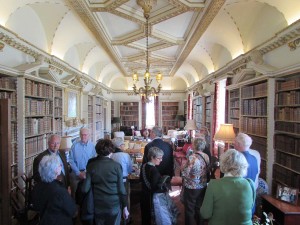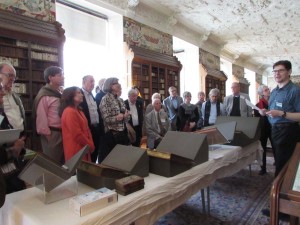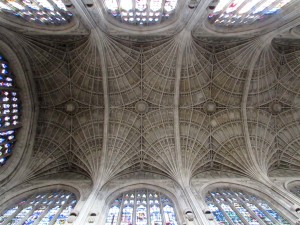Exploring English Libraries and Country Houses
EVENTS > STUDY TRIPS ABROAD
In Review: Fall Study Trip Abroad 2014
Medieval illuminated manuscripts at Wormseley. Gibbes’ Radcliffe Camera in Oxford. The Mughal architectural detailing of Sezincote. Thomas Coke’s personal copy of Palladio at Holkham. King’s College Chapel in Cambridge. Catesby’s Birds of America at Blickling. These recollections are a tiny sample of the memorable experiences shared by the participants in the Trust’s fall Study Trip Abroad, England: British Libraries and Country Houses.
In addition to covering an impressive amount of geographic territory during the sold-out tour, our collective of 26 eager members witnessed nearly 10 centuries of architectural history first-hand as well as the written, illustrated, and printed words that bear witness to Great Britain’s intellectual and cultural achievements during that period. To whet our appetites, a swashbuckling introductory lecture by Mark Purcell, Curator of National Trust Libraries, set the stage for the range of sites and rarities the intrepid bibliophile will encounter when seeking out the intersection of libraries and country houses in England.
Our time in two superlative university towns, Oxford and Cambridge, demonstrated the stunning breadth of their architectural might while also introducing the group to the structure of the British college system and the strength of their collective library holdings. One rarely has the opportunity to examine and appreciate the work of Wren, Gibbes, and Hawksmoor in such rapid succession as when taking in the remarkable quartet formed by the Bodleian, Sheldonian, Radcliffe, and Oxford Press. Indeed, the privilege of admiring no less than a half dozen of Wren’s projects, as we enjoyed on this trip, is typically impossible outside of London.
From the country house angle, we explored a spectacular range of sites from the impossibly grand Blenheim Palace to a quaint and quirky riverside cottage in Quenington. Each visit contributed a unique and worthy take on the development and preservation of these structures and the evolving fortunes of the families who owned them. Luke Lightfoot’s stunning Chinoiserie room for the Earl of Verney at Claydon and William Kent’s enfilade of state rooms for the Earl of Leicester at Holkham are merely two of many memorable vistas enjoyed by our party.
Of course momentous collections of decorative and fine art were included for good measure! The quality of the furnishings at Waddesdon, Holkham, and Blenheim were known entities but enjoyable nonetheless. Further off the beaten path, however, an extraordinary state bed ca. 1700 with embroidered hangings at Drayton was one of many surprises encountered throughout the trip. Extended tours at the Ashmolean and Fitzwilliam allowed access to the riches of these university museums. At the former, we benefitted from the tutelage of Timothy Wilson, former Keeper of Western Art, who introduced the museum’s remarkable holdings of Worcester porcelain as well as the Tradescant Collection of Kunstkammer objects, a recent bequest. With the assistance of curatorial staff at the Fitzwilliam, we enjoyed the privilege of opening a dozen pieces of furniture on exhibition.
These spectacles notwithstanding, the private visits to libraries at Blickling, Wormsley, and Holkham took the proverbial cake. The three collections were assembled at different times under vastly different circumstances, but each demonstrated the tremendous efforts of their creators. The gracious assistance from curators in opening rarities led to oohs and aahs in great profusion, and the vastness of these private holdings defies comprehension.
For instance, the collection at Blickling is currently undergoing a comprehensive recataloguing, and the intrepid young librarian tasked with this mammoth responsibility is in the fourth year of what is likely a twelve-year assignment.
During our closing dinner in the Cotswolds, Trust Governor Helen Scott Reed encouraged fellow participants to share a favorite moment, house, or object from the tour. The responses were as diverse as those who shared in the experiences. A common theme throughout, however, was an appreciation for the collegiality and conviviality of their fellow travelers as well as the recognition of the truly special nature of the tour. We thank all who joined us in England for their support and camaraderie.






